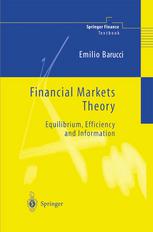

Most ebook files are in PDF format, so you can easily read them using various software such as Foxit Reader or directly on the Google Chrome browser.
Some ebook files are released by publishers in other formats such as .awz, .mobi, .epub, .fb2, etc. You may need to install specific software to read these formats on mobile/PC, such as Calibre.
Please read the tutorial at this link: https://ebookbell.com/faq
We offer FREE conversion to the popular formats you request; however, this may take some time. Therefore, right after payment, please email us, and we will try to provide the service as quickly as possible.
For some exceptional file formats or broken links (if any), please refrain from opening any disputes. Instead, email us first, and we will try to assist within a maximum of 6 hours.
EbookBell Team

0.0
0 reviewsFinancial Markets Theory presents classical asset pricing theory, a theory composed of milestones such as portfolio selection, risk aversion, fundamental asset pricing theorem, portfolio frontier, CAPM, CCAPM, APT, the Modigliani-Miller Theorem, no arbitrage/risk neutral evaluation and information in financial markets. Starting from an analysis of the empirical tests of the above theories, the author provides a discussion of the most recent literature, pointing out the main advancements within classical asset pricing theory and the new approaches designed to address open problems (e.g. behavioural finance). It is the only textbook to address the economic foundations of financial markets theory from a mathematically rigorous standpoint, and to offer a self-contained critical discussion, based on empirical results. Financial Markets Theory is an advanced book, well-suited for a first graduate course in financial markets, economics or financial mathematics. It is self-contained and introduces topics in a setting accessible to economists and practitioners equipped with a basic mathematical background. For those not acquainted with standard microeconomic theory, the tools needed to follow the analysis are presented early in the book. The approach makes this a vital handbook for practitioners in insurance, banking, investment funds and financial consultancy, as well as an excellent graduate-reference textbook.